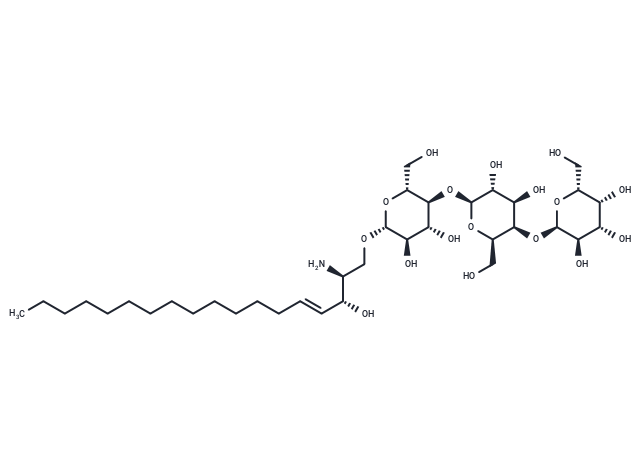- Remove All
 Your shopping cart is currently empty
Your shopping cart is currently empty
Lyso-Globotriaosylceramide (d18:1)
Lyso-globotriaosylceramide is a form of globotriaosylceramide that is lacking the fatty acyl group. It binds to Shiga toxin 1 (Stx1) in the presence of cholesterol and phosphatidylcholine but does not bind Stx2. It also reduces viability and aggregation of human neutrophils induced by phorbol 12-myristate 13-acetate when used at concentrations of 50 and 1 μM, respectively. Lyso-globotriaosylceramide accumulates in the brain, heart, kidney, liver, lung, and spleen in a mouse model of Fabry disease, a lysosomal storage disorder characterized by a deficiency in the enzyme α-galactosidase A. It also accumulates in the urine, kidney, and plasma of patients with Fabry disease. Lyso-globotriaosylceramide levels decrease in response to administration of the α-galactosidase inhibitor 1-deoxygalactonojirimycin in a transgenic mouse model of Fabry disease. Decreases in plasma and urine concentrations of lyso-globotriaosylceramide have been used as a biomarker for efficacy of enzyme replacement therapy (ERT) and other therapies in the treatment of Fabry disease.

Lyso-Globotriaosylceramide (d18:1)
| Pack Size | Price | Availability | Quantity |
|---|---|---|---|
| 1 mg | Inquiry | 35 days |
Product Introduction
| Description | Lyso-globotriaosylceramide is a form of globotriaosylceramide that is lacking the fatty acyl group. It binds to Shiga toxin 1 (Stx1) in the presence of cholesterol and phosphatidylcholine but does not bind Stx2. It also reduces viability and aggregation of human neutrophils induced by phorbol 12-myristate 13-acetate when used at concentrations of 50 and 1 μM, respectively. Lyso-globotriaosylceramide accumulates in the brain, heart, kidney, liver, lung, and spleen in a mouse model of Fabry disease, a lysosomal storage disorder characterized by a deficiency in the enzyme α-galactosidase A. It also accumulates in the urine, kidney, and plasma of patients with Fabry disease. Lyso-globotriaosylceramide levels decrease in response to administration of the α-galactosidase inhibitor 1-deoxygalactonojirimycin in a transgenic mouse model of Fabry disease. Decreases in plasma and urine concentrations of lyso-globotriaosylceramide have been used as a biomarker for efficacy of enzyme replacement therapy (ERT) and other therapies in the treatment of Fabry disease. |
| Alias | Lyso-Globotriaosylceramide (d18:1) |
| Molecular Weight | 785.922 |
| Formula | C36H67NO17 |
| Cas No. | 126550-86-5 |
| Relative Density. | 1.37 g/cm3 (Predicted) |
| Storage | Powder: -20°C for 3 years | In solvent: -80°C for 1 year | Shipping with blue ice. |
| Solubility Information | Chloroform:Methanol:H2O (4:3:1): Soluble |
Calculator
In Vivo Formulation Calculator (Clear solution)
Dose Conversion
Tech Support
Keywords

Copyright © 2015-2025 TargetMol Chemicals Inc. All Rights Reserved.




